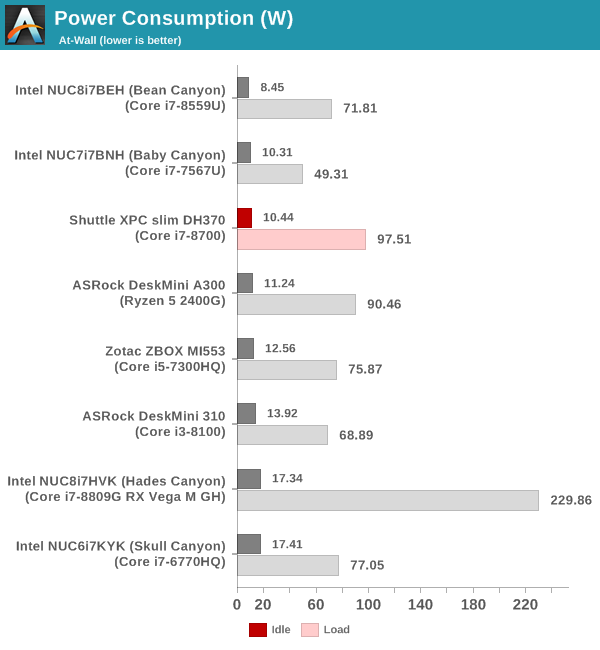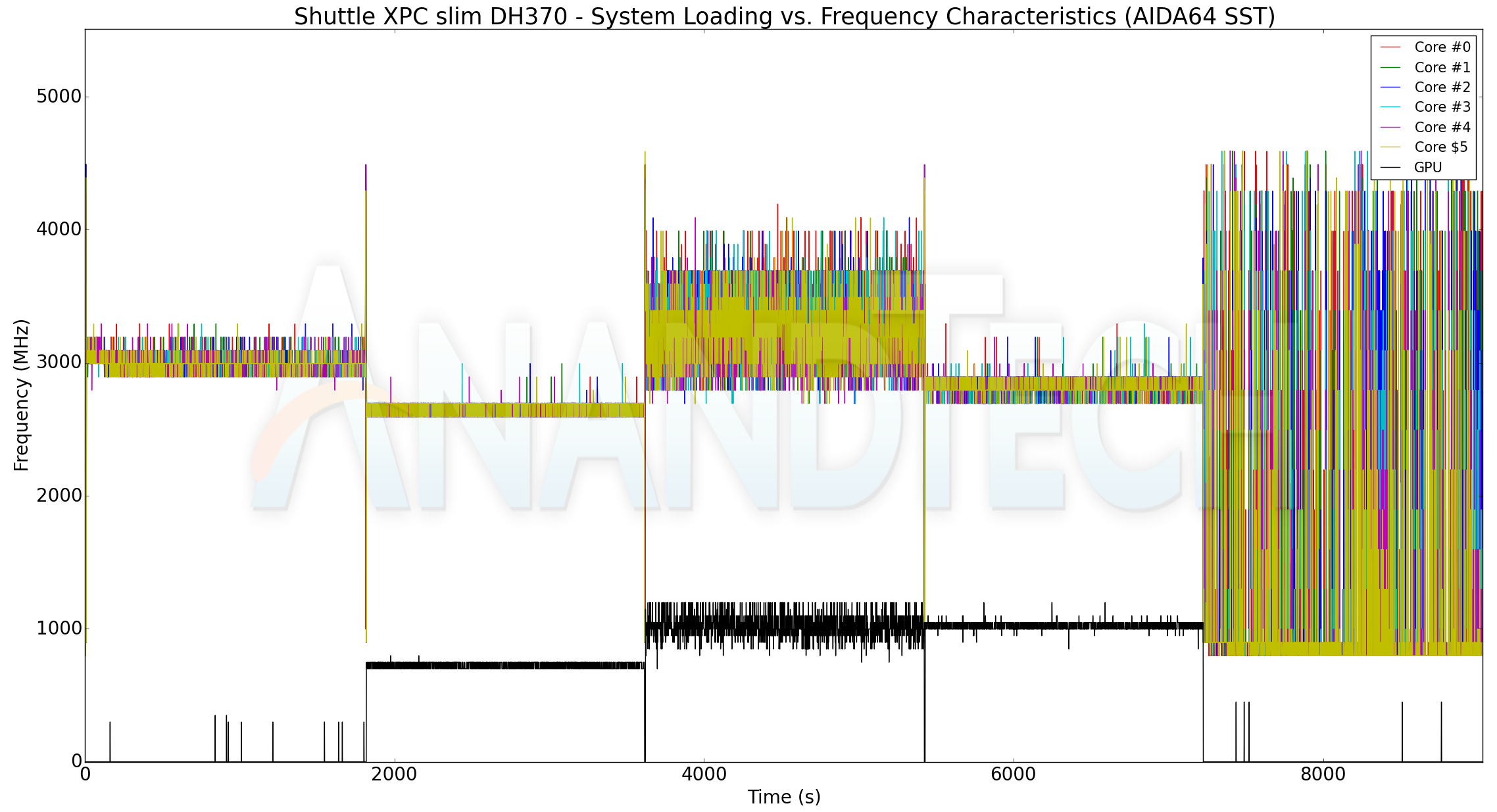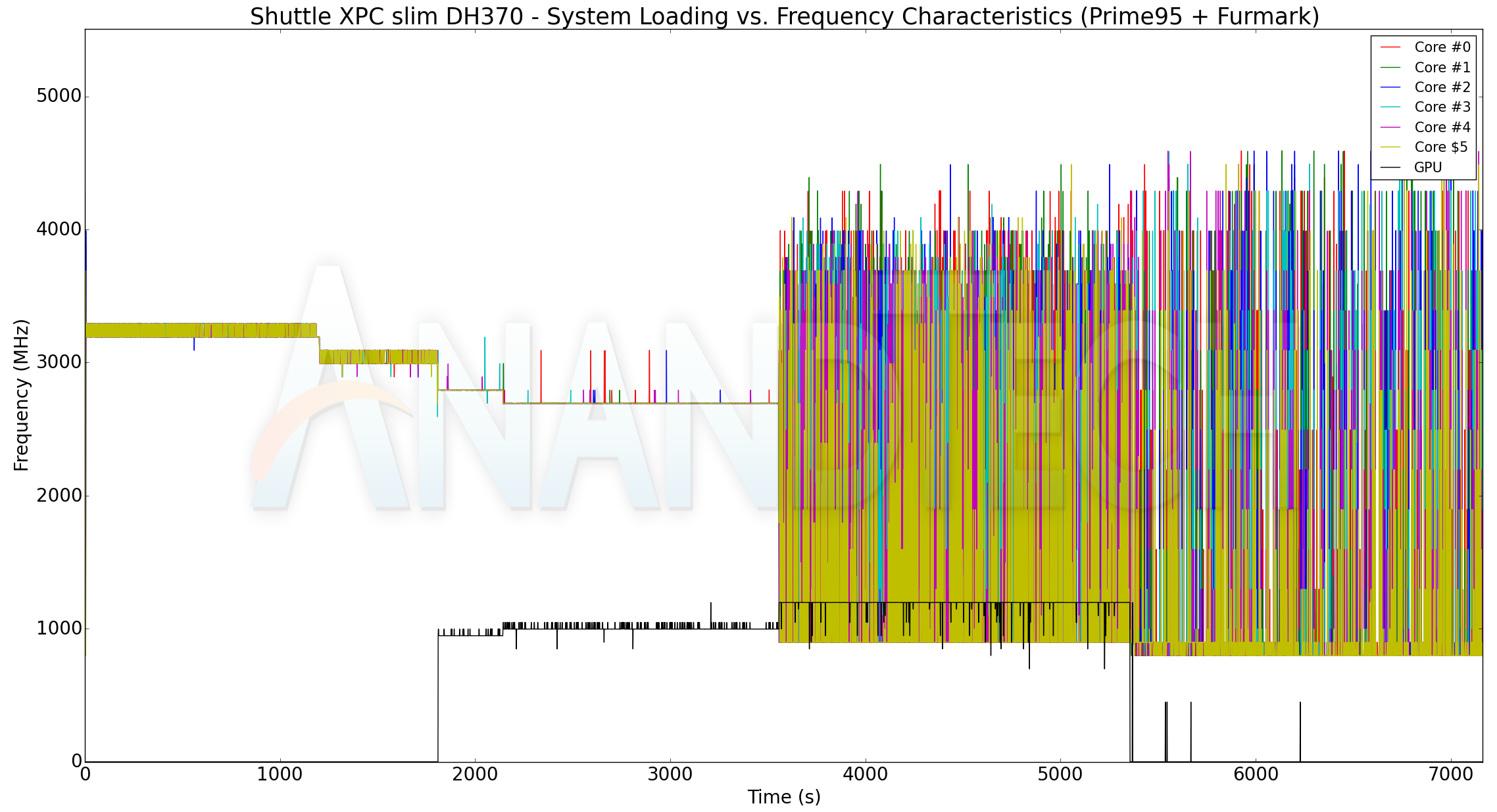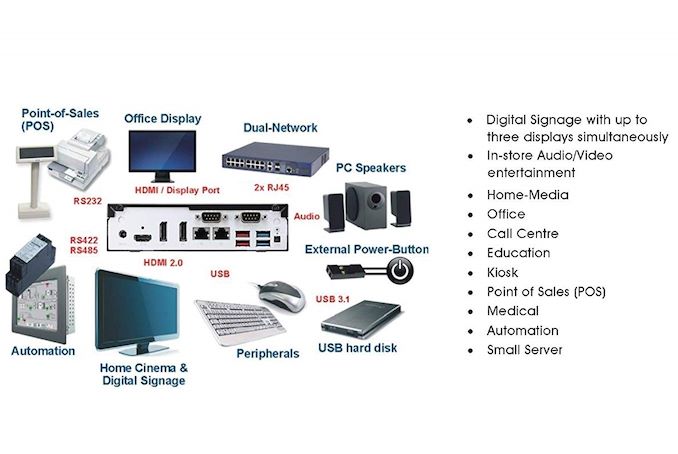Shuttle XPC slim DH370 mini-PC Review: A Compact Digital Signage Powerhouse
by Ganesh T S on May 6, 2019 8:00 AM ESTMiscellaneous Aspects
We have taken a detailed look at the performance of the Shuttle XPC slim DH370 and its suitability for different use-cases in its target markets. Prior to providing some concluding remarks, it is important to get an idea of the power consumption numbers for the system as well as the efficiency of its cooling solution.
Power Consumption
The power consumption at the wall was measured with a 4K display being driven through the HDMI port. In the graphs below, we compare the idle and load power of the Shuttle XPC slim DH370 with other low power PCs evaluated before. For load power consumption, we ran the AIDA64 System Stability Test with various stress components, as well as our custom Prime95 / Furmark loading scripts, and noted the maximum sustained power consumption at the wall.

The system's 10.44W idling power is praiseworthy, given the choice of components. Stressing the 65W TDP processor also makes the system sustain more than 97W at the wall. This is in contrast to the 69W stress number for the 65W TDP Core i3-8100 in the DeskMini 310. The design of the Shuttle XPC slim allows for taking full advantage of the capabilities of the installed processor.
Thermal Performance
Our thermal stress routine starts with the system at idle, followed by four stages of different system loading profiles using the AIDA64 System Stability Test (each of 30 minutes duration). In the first stage, we stress the CPU, caches and RAM. In the second stage, we add the GPU to the above list. In the third stage, we stress the GPU standalone. In the final stage, we stress all the system components (including the disks). Beyond this, we leave the unit idle in order to determine how quickly the various temperatures in the system can come back to normal idling range. The various clocks, temperatures and power consumption numbers for the system during the above routine are presented in the graphs below.
| Shuttle XPC slim DH370 System Loading with the AIDA64 System Stability Test | |||

Despite being rated for operation at 3.2 GHz, the cores spend a majority of their time around the 3 GHz mark in the course of the AIDA stress test. The GPU operates at up to 1.2 GHz. The temperatures always stay south of 85C. The power numbers are more interesting. When all components are getting stressed, the CPU package power is constant around 48W. The interesting aspect to note here is that there is not much variation in the package power for each workload component.
We also run a custom stress test involving Prime95 and Furmark. Starting with Prime95 alone, we add Furmark to the mix after 30 minutes. After another 30 minutes of simultaneous CPU and GPU loading, we terminate the Prime95 process alone and let the GPU run at full throttle. The metrics graphed for the AIDA64 system stability test are also graphed here.
| Shuttle XPC slim DH370 System Loading with Prime95 and Furmark | |||

Our custom test is much more stressful. We see the cores starting out at 3.2 GHz, but, Prime95 makes them reach 90C around 20 minutes into the test. Once the temperature goes above, we see the cores clock down to around 3 GHz. Despite the lower clocks, the package power actually rises from around 50W to 52W. The addition of Furmark to the mix brings down the package power to 45W, and running only Furmark results in a package power dissipation of around 40W. Obviously, the latter two cases are much easier to handle for the cooling solution and we see the temperatures dropping rapidly.
Concluding Remarks
The Shuttle XPC slim DH370 is a compact computing powerhouse. All our benchmark numbers point to that. Shuttle's choice of RAM and SSD for our review configuration actually hold back the numbers a bit. Upgrading the RAM kit (to, say, DDR4-2666) and the SSD (to, say, a PCIe 3.0 x4 NVMe one) would only serve to make the already chart-leading performance better. The choice of external high-speed I/O - in particular, making all four possible USB 3.1 Gen 2 ports come out, is laudable. Dual Intel NICs ought to make the DH370 a good fit for certain networking use-cases.
Shuttle targets various market segments, as shown in their product brief. The DH370 is a very good fit for all of them, but, with caveats. The system can indeed drive three different 4Kp60 displays with HDR simultaneously. However, end-users should note that the usage of this mode may result in performance loss for some of the system workloads. For in-store and home media playback and entertainment, the XPC slim DH370 ticks all the right boxes, but, the fan noise is a definite factor. It is possible that a T-series processor might not stress the cooling system as much. However, the configuration we evaluated was simply too noisy for use as a HTPC. The drawbacks we encountered are not much of a factor for the other targeted applications.
The Shuttle XPC slim DH370 deserves a lot of praise for incorporating a balanced set of features available in the Intel H370 platform into a compact system. The thermal solution (pictured above) does a lot of the heavy lifting to allow the installed processor to perform to its potential. However, its noise profile is also the one trade-off that consumers have to make for the compact size of the system. The $330 barebones price for the system is also reasonable considering the standalone prices for a good H370 motherboard, chassis, and PSU.
Shuttle does have scope for improving the DH370 further - for starters, we would have liked a couple of the USB 3.1 Gen 2 Type-A ports to be Type-C. A Thunderbolt 3 port would have also been nice to have, given that spare PCIe lanes from the PCH as well as the CPU are available. That said, Shuttle's unique features (such as the triple 4K display output) are quite difficult to achieve in a DIY build in this form factor. Based on the results of our evaluation, we recommend the Shuttle XPC slim DH370 for purchase after careful analysis of the expected use-cases.












37 Comments
View All Comments
timecop1818 - Monday, May 6, 2019 - link
Intel CPUs only have native DisplayPort output, not HDMI (licensing?). Nothing is technically preventing fullly complaint HDCP 2.2 path when using the MCDP part - unless shuttle cheaped out and didn't include the keys? Anyway i never looked into this as HDMI port is never something I'm looking for in a PC. I'm curious what exactly prevents the playback, as the same part (or a similar one from Parade tech) is what would be used inside a USBC to HDMI 2.0 cable as well.ganeshts - Monday, May 6, 2019 - link
All three display outputs support HDCP 2.2Intel supports HDMI, but, only 1.4a as of now. If OEMs want to put a HDMI 2.0a port, then, that HDMI capability of the Intel CPU is left un-used.
Some LSPCons do not do Stereoscopic 3D forwarding, which results in the loss of 3D capabilities.
rchris - Monday, May 6, 2019 - link
Thanks for a good review. But please include physical dimensions; particularly important when you're reviewing a compact system. The volume specs are nice, but not sufficient. Yes, they are available at the "Full Specifications" link, but would be more helpful to be in your article.Guspaz - Monday, May 6, 2019 - link
Be wary of Shuttle claims that their systems support standard motherboards. I bought a Shuttle XPC SZ77R5. Years later, the motherboard died and Shuttle wanted an absurd amount of money for the replacement (enough to buy a whole new computer). They claimed in the advertising for the system that it was "easily" upgradable with any standard mini-itx motherboard. In fact, the product website STILL says that.Three problems: the case uses a non-standard motherboard standoff height, and does not include any standoffs. There are a few of them directly welded to the chassis, but only enough for Shuttle motherboards, more are required for a mini-ITX board. I couldn't even find any of the right height online to buy, short of ordering them in bulk from China and waiting a few months. Instead, I had to take standard brass motherboard standoffs and filed them down by hand. It took hours.
Second: the included power supply didn't have a full-width power connector that mini-ITX motherboards required. Luckily, the missing pins were just for providing power, so they seem to be in the "strongly recommended but technically not required" category, and it worked OK without them.
Third: Shuttle motherboards don't have the CPU in the same location as a mini-ITX motherboard, so the system's custom heatpipe-based cooling system must be thrown out and replaced by traditional air cooling, which is less effective.
Death666Angel - Monday, May 6, 2019 - link
Well, mITX motherboards don't have the CPU sockets in the same location, so that point is moot. And all I just read about their advertising the ITX compatiblity (granted, I only found the German site) is that they said you can use mITX motherboards without having to modify the case. And that seems right, doesn't it?Guspaz - Wednesday, May 8, 2019 - link
It was not really true for the SZ77R5, no. Because short of fabricating custom mounting hardware like I did, you would have needed to modify the case with a deemed to install an mITX board. Requiring mounting hardware that does not exist is far from the easy upgradability they claimed. Now, hopefully this isn’t the case with the product that is the subject of this anandtech article. But I’ve been burned by them before.Guspaz - Wednesday, May 8, 2019 - link
*with a dremel, not a “deemed”timecop1818 - Monday, May 6, 2019 - link
Dude this is a completely non-standard SFF motherboard that doesn't follow any particular layout or spec. Do you complain that Intel NUC doesn't fit into Mini ITX board? There are no claims made anywhere that this board is user replaceable.0ldman79 - Tuesday, May 7, 2019 - link
"Mini-ITX Mainboard SupportShuttle expands the capabilities of its R chassis, adding support for Mini-ITX mainboards (17 x 17cm or 6.7 x 6.7 inches). The Shuttle chassis can go beyond the Shuttle mainboard, so you can easily upgrade or downgrade the mainboard to your desire, without any modifications to the chassis."
http://global.shuttle.com/main/productsDetail?prod...
timecop1818 - Tuesday, May 7, 2019 - link
Yes and that link has nothing to do with the product reviewed here...